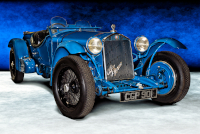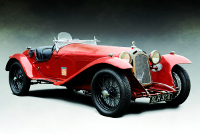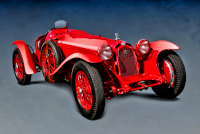Location:
Simeone Foundation Automotive Museum Demo Day, 2023
Owner: Simeone Foundation Automotive Museum | Philadelphia, Pennsylvania
Prologue:
Only a glimpse, but the car is remarkable... We glanced at chassis #2311201 while visiting the Simeone Foundation for an in-depth look at the 8C 2900B Mille Miglia Touring Spider and Bugatti Type 57G Tank. The long-chassis Le Mans 8C is a grand car, however, and worthy of more visual attention than I can give just now. From a historical standpoint, the Tipo Le Mans Touring Spider is one of the most successful of the entire 8C stable, winning Le Mans every year from 1931 to 1934, and yet it is also one of the most exclusive, with only nine cars built in that period.
Here, we discuss a bit of the 5th Lord Earl Howe—who he was and what the title means—as well as the car he drove at Le Mans in 1934. And with luck, some day we'll be able to expand on the visual dynamics.
- - - - - - - - - -
► Image Source: Nikon D750 (23.4 MP)
References:
- Czap, Nick. "Museo Storico Alfa Romeo: The Catalogue" Giorgio Nada Editore, Milano, Italia. 2015, page 167
- Simeone Foundation Automotive Museum: The foundation's own description of chassis #2311201 includes more detail on the car's origins and correspondence with Lieutenant-Commander Kidston.
- FCA Heritage: FCA Heritage cares for the first Lord Howe 8C 2300 Le Mans, chassis #2111005, on behalf of Museo Storico. The car shown here by FCA is also the same car that appears in the Museo Storico book cited above. FCA provide more history on 8C 2300 Le Mans dominance.
- UltimateCarPage: A well conceived survey of the 8C 2300 Le Mans, with a gallery of six examples, by Wouter Melissen, June 25, 2012.
- Wikipedia: A bit of biography on Francis Richard Henry Penn Curzon, the 5th Earl Howe.
A change of attitude from the 6C, Alfa Romeo developed a comprehensive racing program around the 8C. The Simeone Foundation notes, by way of Simon Moore, that as of 1930 the plan addressed the Mille Miglia, the Targa Florio, Grand Prix racing, and here, the Le Mans 24-hour race. Different chassis and body styles suited each endeavor: the corto chassis for the Mille Miglia, stripped-down versions of the corto chassis for the Targa Florio, the monoposto Monza for Grands Prix (with some biposto for the Mille Miglia), and of course the rare lungo chassis for Le Mans specifications. This is the program that supplants both the Bugatti Type 35 and Bentley 3-Litre as the eminent sports-racing car in Europe.
Le Mans required a four-place car and Alfa accommodated the rule with a rather long wheelbase grown to incongruously lengthy proportions with a rear-mount spares compartment. Alfa Romeo built nine of these Tipo Le Mans specification cars, a very small sample of the 300 or so chassis built, about two-thirds of which were dedicated to motor racing.
Chassis #2311201 is the second car owned and raced by Lord Earl Howe, the first of which is #2111005. The Simeone Foundation Automotive Museum in Philadelphia cares for this blue Le Mans entry from 1934, whereas FCA Italy S.P.A. in Torino, Italy cares for the Earl's 1931 entry, (part of the Museo Storico collection), which won the race outright. 1931 served as the first of four consecutive Alfa Romeo 8C victories on the Mille Miglia.
Museo Storico notes that the original 1931 car (#2111005) retained its Alfa red paint in order that Lord Howe demonstrated solidarity with the factory team. (And the team in turn, supported Lord Howe.) No doubt the factory were thrilled that he delivered Alfa Romeo's first Le Mans win in a red car. Lord Howe donned his trademark blue livery on his overalls and cap for the win, and then in his 1934 Le Mans reprise he painted his uprated car just the same.
Explaining the Lord Earl Howe Title and Lineage
To deviate into the actors for a moment, Lord Earl Howe is an English title of the houses Howe and Curzon-Howe, also comprised of barons and viscounts, most of whom served in the British Army, Navy, or Parliament, or in some ambassadorial role. The Earl Howe in question here is the 5th Earl of the second creation of the lineage begun in 1821. His name is Francis Richard Henry Penn Curzon, previously known as Viscount Curzon from 1900 to 1929, and a member of the British Navy and Parliament. He and Sir Henry Birkin (Tim Birkin) won the 1931 Le Mans race in the aforementioned first-series 8C 2300.
The 5th Earl Howe oscillated between military duties and the racing world as conflict waxed and waned. In the latter field, he performed organizational roles in team preparation and broader race organizing, serving as formative president of the British Racing Drivers' Club (BRDC) from 1929 (one year after its constitution) until 1964.
Back on the racing line... In 1934, Howe and Tim Rose-Richards (home-grown racing driver of Welsh origin) retired from the 1934 Le Mans race in chassis #2311201 with clutch failure after 1,146 kilometers. However, the pair set the fastest lap of the race at 5:47.9 at an average speed of 86.75 miles per hour.
The car later transferred from the 5th Earl Howe to his son-in-law, Lieutenant-Commander Home Kidston of the Royal Navy, younger brother of aviator and racing driver Glen Kidston, same family of the present-day Simon Kidston. And so chassis #2311201 traces its roots to two illustrious racing families of British racing history. Lineage and a fastest lap make this 8C Tipo Le Mans a fitting member of today's Simeone collection—not merely an incredible collection, but one in which the cars routinely stretch their legs. Blue paint the preference of Howe and a gently worn patina keep the spirit of competition alive, not to be glossed over by restoration, which is the way Dr. Simeone wanted great old race cars to remain.
Motor: 2,336 cc straight 8-cylinder, alloy block, aluminum hemi-head | 65 mm x 88 mm | 6.6:1 compression
Valvetrain: DOHC, 2 valves per cylinder
Aspiration: Memini carburetor, Roots-type supercharger
Power: 180 bhp at 5,200 rpm
The original Tipo Le Mans produced 155 bhp in 1931; motor development bumped that figure upward for the 1934 cars.
Drivetrain: 4-speed gearbox, rear-wheel drive
Front Suspension: beam axle, semi-elliptic leaf springs, friction dampers
Rear Suspension: live axle, semi-elliptic leaf springs, friction dampers
Architecture: pressed steel chassis with aluminum coachwork by Touring of Milan
Kerb Weight: 1,080 kg (2,380.9 lbs)
Wheelbase: 3,098 mm (121.9 inches)
0-60: 215 km/h (133.5 mph)
Etymology:
'8C 2300' refers to the motor configuration, a straight 8-cylinder of just over 2.3 litres displacement. The Alfa Romeo factory museum uses the term 'torpedo' to describe the body in lieu of the typical spider configuration, or 'Touring Spider,' which pertains to the Corto Mille Miglia Touring Spider. This Lungo Tipo Le Mans car is technically cut from the same cloth, just more of it. The term 'lungo torpedo' is probably more accurate for the original cars as of 1931, though they all became known as the Le Mans for their recurring duty at Circuit de la Sarthe.
Figures:
Various reports cite that Alfa Romeo built anywhere between 188 and 195 8C 2300 cars, perhaps limited to racing device—short and long chassis, Monza included—many of which targeted specific international events depending on configuration. Alfa Romeo built the cars in three series, with an additional group provided specially for Scuderia Ferrari. The factory's own figure of 308 total 8C 2300 cars produced between 1931 and 1934 may comprise all manner of road and racing variants, leaving approximately two-thirds for the latter use. Of these, Touring built nine cars to Le Mans specifications from 1931 to 1934. Note that the Simeone Foundation cites eight examples, where as we use the number cited by Alfa Romeo Museo Storico. Either way, the Tipo Le Mans is a very limited production race car among all 8C series.
Long Wheelbase: Proportions of the Le Mans Specification 8C Alfa
Clipped by our foreshortened perspective, the rare lungo wheelbase stretches over 3,000 mm, better proportioned for a touring car than an endurance racer. The tonneau cover behind the cockpit conceals a rear seat in deference to Le Mans requirements and justifies the acreage. Spares sit even farther back within a bulky compartment under a hatch with a central blade, aerodynamic Le Mans counterpoint to the Corto Mille Miglia Touring Spider and its Hermes helmet.
We must however leave that detail to other depictions. I would think most anyone could capture the same posture shown here, only that the mechanics and level of finish differ. Such is the predictability of a museum's static display, and the reason I have not worried too much over the diversity of images.
With extra length, the cut-down doors sweep broadly along the flank, almost sleigh-like, tapering into a deep smile that takes away a substantial amount of protection from the driver. Ahead, two racing windscreens sit above the collapsible rectangular glass pane. Cycle fenders cover the tyres, each with hefty riveted fasteners that connect to a mad collection of struts, and the rears incorporate toolboxes with nominal aerodynamic housings on the front faces. The long body does not keep what it does not need, yet it bulks up the structure.
I particularly like the jungle-gym front end with its A-arm light stanchions that double as the mount points for one of three partly flexible pairs of struts securing the front wings. A pleasant mess, the fascia looks highly technical and fits the snarl of the supercharged straight 8-cylinder.
Bentley Italiana: Comparing the Le Mans 8C Alfa with the Bentley 3-Litre Speed Model
Overall, this formula hearkens back to the Bentley 3-Litre Speed Model. In comparison, the 8C is of course lower and leaner with rudimentary aerodynamic touches. Certainly the drivetrain is more exotic. But in this way, the 8C 2300 Tipo Le Mans is an Italian take on the English formula. As evidence of Alfa Romeo's vast aspirations, we might see the 8C 2300 Monza as an evolution of the Type 35 and superior counterpart to the Type 51. But Alfa clearly looked at Le Mans differently and opted for the truck approach, building up the 8C platform into a sturdy device. And this approach explains why Alfa built so few of the Tipo Le Mans; it is really only suited for Le Mans, and rather obsolete elsewhere. Not so surprising, one year after the 8C's fourth and final Le Mans win in 1934, 1935 (the year of Lagonda's lone victory) is the final edition in which Le Mans requires a four-place race car.
Last Updated: Mar 26, 2025





